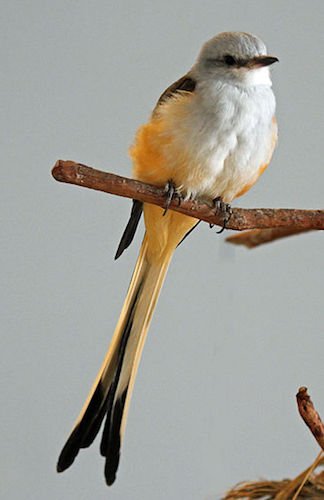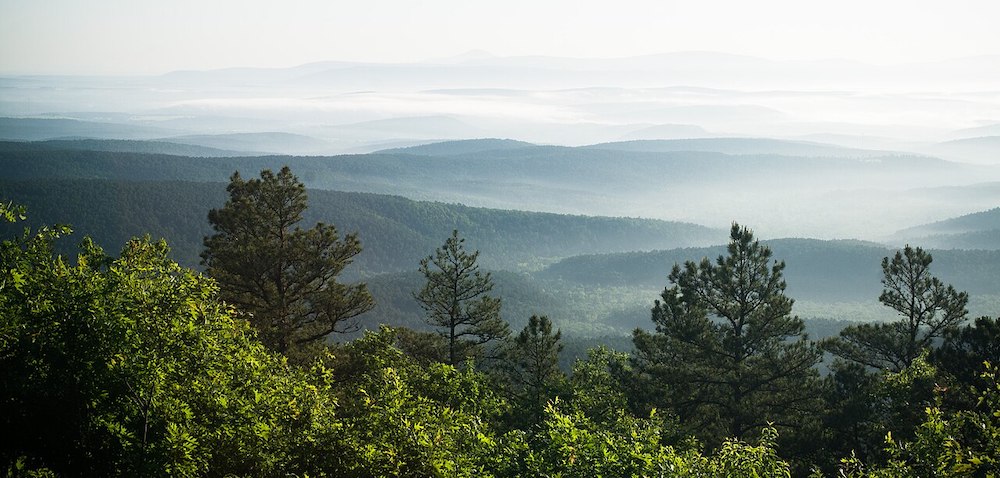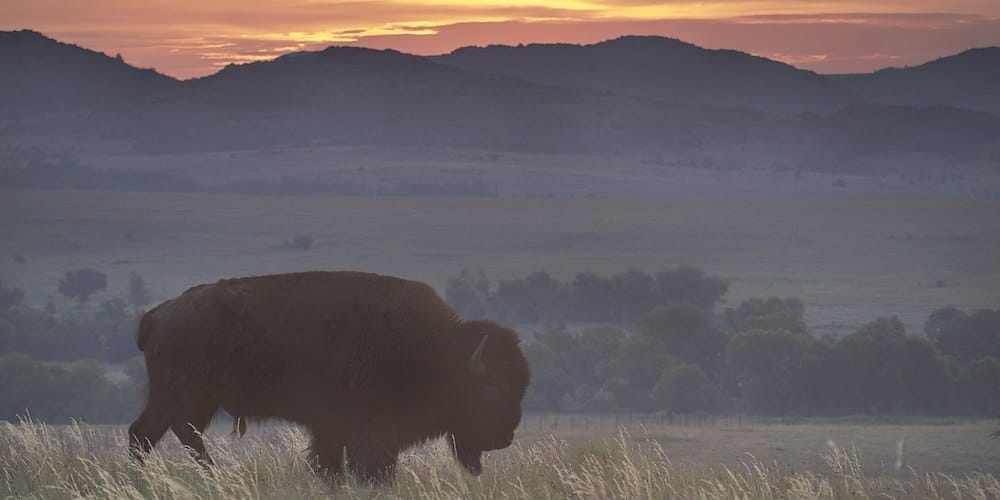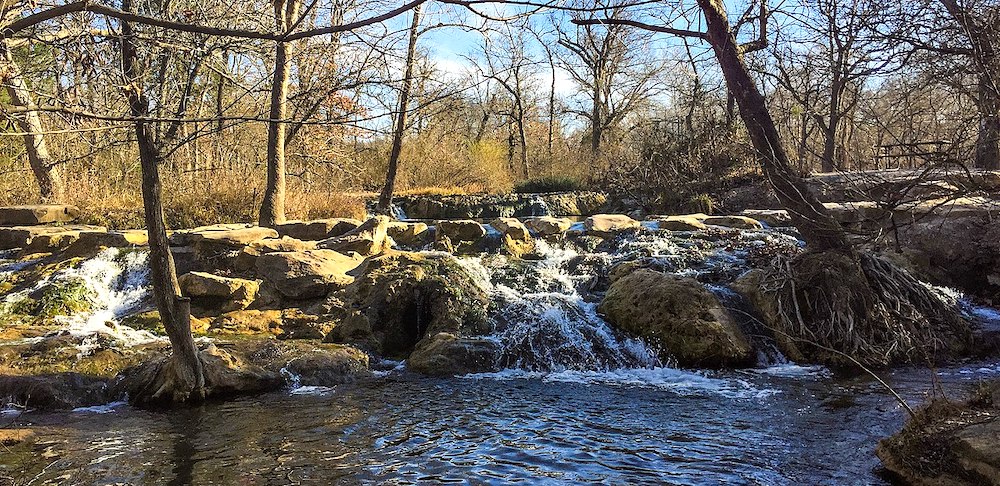State of Oklahoma

Oklahoma is a state in the South Central region of the United States. It borders Texas to the south and west, Kansas to the north, Missouri to the northeast, Arkansas to the east, New Mexico to the west, and Colorado to the northwest. Partially in the western extreme of the Upland South, it is the 20th-most extensive (covering a little over 180,500 km2 (almost 70,000 square miles) and the 28th-most populous of the 50 United States. Its residents are known as Oklahomans and its capital and largest city is Oklahoma City with around one million inhabitants a quarter of the state’s total population. The state’s name is derived from the Choctaw words okla, ‘people’ and humma, which translates as ‘red’. Oklahoma is also known informally by its nickname, ‘The Sooner State’, in reference to the Sooners, American settlers who staked their claims in formerly American Indian-owned lands until the Indian Appropriations Act of 1889 authorized the Land Rush of 1889 opening the land to settlement.
With ancient mountain ranges, prairie, mesas, and eastern forests, most of Oklahoma lies in the Great Plains, Cross Timbers, and the US Interior Highlands, all regions prone to severe weather. It is at a confluence of three major American cultural regions. Historically, it served as a government-sanctioned territory for American Indians moved from east of the Mississippi River, a route for cattle drives from Texas and related regions, and a destination for Southern settlers. There are currently 26 Indigenous languages spoken in Oklahoma. According to the 2020 US census, 14.2 percent of Oklahomans identify as American Indians, the highest indigenous population by percentage in any state.
Oklahoma is between the Great Plains and the Ozark Plateau in the Gulf of Mexico watershed, generally sloping from the high plains of its western boundary to the low wetlands of its southeastern boundary. Among the most geographically diverse states, Oklahoma is one of four to harbor more than 10 distinct ecological regions, with 11 in its borders—more per square mile than in any other state. Its western and eastern halves, however, are marked by extreme differences in geographical diversity: Eastern Oklahoma touches eight ecological regions and its western half contains three. Although having fewer ecological regions Western Oklahoma contains many rare, relic species.

Ouachita Mountains – ©Justin Meissen CC BY-SA 2.0 via Wikimedia Commons
Oklahoma has four primary mountain ranges: the Ouachita Mountains, the Arbuckle Mountains, the Wichita Mountains, and the Ozark Mountains. Contained within the US Interior Highlands region, the Ozark and Ouachita Mountains are the only major mountainous region between the Rocky Mountains and the Appalachians. A portion of the Flint Hills stretches into north-central Oklahoma. The semi-arid high plains in the state’s northwestern corner harbour few natural forests; the region has a rolling to flat landscape with intermittent canyons and mesa ranges like the Glass Mountains. Partial plains interrupted by small, sky island mountain ranges like the Antelope Hills and the Wichita Mountains dot southwestern Oklahoma; transitional prairie and oak savannas cover the central portion of the state. The Ozark and Ouachita Mountains rise from west to east over the state’s eastern third, gradually increasing in elevation in an eastward direction.
More than 500 named creeks and rivers make up Oklahoma’s waterways, and with 200 lakes created by dams, it holds the nation’s highest number of artificial reservoirs. Most of the state lies in two primary drainage basins belonging to the Red and Arkansas Rivers, though the Lee and Little Rivers also contain significant drainage basins.
Forests cover 24 percent of Oklahoma and prairie grasslands composed of shortgrass, mixed-grass, and tallgrass prairie, harbour expansive ecosystems in the state’s central and western portions, although cropland has largely replaced native grasses. Where rainfall is sparse in the state’s western regions, shortgrass prairie and shrublands are the most prominent ecosystems, though pinyon pines, red cedar (junipers), and ponderosa pines grow near rivers and creek beds in the panhandle’s far western reaches. Southwestern Oklahoma contains many rare, disjunct species, including sugar maple, bigtooth maple, nolina, and Texas live oak. Marshlands, cypress forests, and mixtures of shortleaf pine, loblolly pine, blue palmetto, and deciduous forests dominate the state’s southeastern quarter, while mixtures of largely post oak, elm, red cedar Juniperus virginiana, and pine forests cover northeastern Oklahoma.

Wichita Mountains Wildlife Refuge – ©Larry Smith CC BY 2.0 via Wikimedia Commons
The state holds populations of white-tailed deer, mule deer, antelope, coyotes, mountain lions, bobcats and elk. In prairie ecosystems, American bison, greater prairie chickens, badgers, and armadillo are common, and some of the nation’s largest prairie dog towns inhabit shortgrass prairie in the state’s panhandle. The Cross Timbers, a region transitioning from prairie to woodlands in Central Oklahoma, harbours 351 vertebrate species. The Ouachita Mountains are home to black bear, red fox, grey fox, and river otter populations, which coexist with 328 vertebrate species in southeastern Oklahoma. Also in southeastern Oklahoma lives the American alligator.
Oklahoma has fifty-one state parks, six national parks or protected regions, two national protected forests or grasslands, and a network of wildlife preserves and conservation areas. Six percent of the state’s 10 million acres (40,000 km2) of forest is public land, including the western portions of the Ouachita National Forest, the largest and oldest national forest in the Southern United States. With 39,000 acres (160 km2), the Tallgrass Prairie Preserve in north-central Oklahoma is the largest protected area of tallgrass prairie in the world and is part of an ecosystem that encompasses only ten percent of its former land area, once covering fourteen states. In addition, the Black Kettle National Grassland covers 31,300 acres (127 km2) of prairie in southwestern Oklahoma. The Wichita Mountains Wildlife Refuge is the oldest and largest of nine National Wildlife Refuges in the state, encompassing 59,020 acres (238.8 km2). Of Oklahoma’s federally protected parks or recreational sites, the Chickasaw National Recreation Area is the largest, with 9,898.63 acres (40.0583 km2). Other sites include the Santa Fe and Trail of Tears national historic trails, the Fort Smith and Washita Battlefield national historic sites, and the Oklahoma City National Memorial.

Chickashaw NRA – ©Victoria Stauffenberg, Public domain, via Wikimedia Commons
Oklahoma is in a humid subtropical region that lies in a transition zone between semiarid further to the west, humid continental to the north, and humid subtropical to the east and southeast. Most of the state lies in an area known as Tornado Alley. Because of Oklahoma’s position between zones of differing prevailing temperature and winds, weather patterns within the state can vary widely over relatively short distances, and they can change drastically in a short time. The humid subtropical climate of central, southern, and eastern Oklahoma is influenced heavily by southerly winds bringing moisture from the Gulf of Mexico. Traveling westward, the climate transitions progressively toward a semiarid zone in the high plains of the Panhandle and other western areas from about Lawton westward, less frequently touched by southern moisture. Precipitation and temperatures decline from east to west accordingly, with areas in the southeast averaging an annual temperature of 17 °C and an annual rainfall of generally over 40 inches and up to 56 inches, while areas of the (higher-elevation) panhandle average 14 °C, with annual rainfall under 17 inches. The entire state frequently experiences temperatures above 38 °C or below −18 °C, though below-zero temperatures are rare in south-central and southeastern Oklahoma. Snowfall ranges from an average of less than 4 inches in the south to just over 20 inches on the border of Colorado in the panhandle.
Birding Oklahoma
The state holds populations of quail, doves, cardinals, Bald Eagles, Red-tailed Hawks, and pheasants. In prairie ecosystems, Greater Prairie-chickens are common. If birding only is your wish, check out a few of our most popular areas: Great Salt Plains, Ouachita Mountains and the vast open prairies.
Oklahoma is a land of friendly people, diverse eco-regions and fantastic birding all year long. It has many locations to bird. Plan to visit one of the 50 state parks. You’ll find any number of activities, including camping, hiking, swimming, fishing, water skiing and even cave exploring, as well, of course, as birding. Check out the Audubon Society of Central Oklahoma for free birding trips and programs.
-
Number of bird species: 494
(As at November 2024)State Bird: Scissor-tailed Flycatcher Muscivora forficata
-
Avibase
PDF ChecklistThis checklist includes all bird species found in Oklahoma , based on the best information available at this time. It is based on a wide variety of sources that I collated over many years. I am pleased to offer these checklists as a service to birdwatchers. If you find any error, please do not hesitate to report them. -
Birds of Oklahoma
ChecklistOklahoma Bird Checklist -
Oklahoma Ornithological Society
Annotated ChecklistThere are 488 species on this checklist. The 421 species documented with voucher specimens have no indicator before their names. The 52 species that have been documented with a recognizable photograph have an asterisk (*) preceding their names. The 13 species seen in the State and supported only by written documentation, and two species of uncertain origin (Mute Swan and Monk Parakeet), have brackets [ ] around their names. Also, two species now extinct (Passenger Pigeon and Carolina Parakeet), and two species possibly extinct (Eskimo Curlew and Ivory-billed Woodpecker), have an obelisk (†) preceding their names. -
eBird
PDF Checklisthis checklist is generated with data from eBird (ebird.org), a global database of bird sightings from birders like you. If you enjoy this checklist, please consider contributing your sightings to eBird. It is 100% free to take part, and your observations will help support birders, researchers, and conservationists worldwide.
-
All About Birds Texas & Oklahoma
| By Cornell Lab of Ornithology (CLO) | Princeton Universityt Press | 2022 | Paperback | 320 pages, 952 colour photos, colour distribution maps | ISBN: 9780691990064 Buy this book from NHBS.com -
Birds of Oklahoma
| By Marc Parnell | Naturalist & Traveller Press | 2022 | Paperback | 316 pages, colour photos | ISBN: 9781954228368 Buy this book from NHBS.com -
Compact Guide to Oklahoma Birds
| By Ted Cable & Gregory Kennedy | Lone Pine Publishing | 2007 | Paperback | ISBN: 9789768200235 Buy this book from NHBS.com -
Distributions of Oklahoma Birds
| By DS Wood & GD Schnell | University of Oklahoma Press | 1984 | PAPERBACK | 232 pages, 382 maps | ISBN: 9780806118871 Buy this book from NHBS.com -
Oklahoma Bird Life
| By B Frederick M Baumgartner & A Marguerite Baumgartner | University of Oklahoma Press | 1992 | Hardback | 548 pages, 51 col plates, 154 b/w photos, 58 line illustrations, 3 maps | ISBN: 9780806117928 Buy this book from NHBS.com -
Oklahoma Birds : An Introduction to Familiar Species
| (Pocket Naturalist) Waterford Press | 2001 | Unbound | ISBN: 9781583550083 Buy this book from NHBS.com -
Oklahoma Breeding Bird Atlas
| Edited by Dan L Reinking | University of Oklahoma Press | 2004 | 528 pages, 222 colour illustrations, 230 col maps | ISBN: 9780806136141 Buy this book from NHBS.com -
Oklahoma Winter Bird Atlas
| By Dan L Reinking | University of Oklahoma Press | 2017 | Paperback | 552 pages, colour photos, colour illustrations, colour distribution maps | ISBN: 9780806158976 Buy this book from NHBS.com
-
Birdlam
InformationBirdlam is Oklahoma’s big day birding event sponsored by the Payne County Audubon Society. Held on the fourth Saturday in April, the aim of Birdlam is to raise funds for Audubon chapters and other bird clubs across the state, increase general awareness of the avifauna diversity within Oklahoma, and … have fun! -
Lesser Prairie-Chicken Festival
Facebook PageThe 2019 Lesser Prairie-Chicken Festival will be held April 10-17, 2019 Featuring keynote speaker Kenn Kaufman. Join us in Woodward, Oklahoma, in northwest Oklahoma April 10-17 for the 2019 Lesser Prairie-Chicken Festival. The 2019 festival will feature keynote speaker Kenn Kaufman. Besides seeing the Lesser Prairie-Chickens (and so far 99% of participants have had close looks!) and birding around northwest Oklahoma, we are again offering these special features for 2019: An opportunity to view Greater Prairie-Chickens from blinds in Osage County, Oklahoma and packages designed specifically for photographers!
-
George Miksch Sutton Avian Research Centre
Observatory WebsiteSatellite ViewThe Sutton Center is situated on 40 acres of an oak-covered hilltop near Bartlesville, Oklahoma. An 8,000 square foot administration building provides office, library, conference, and dining space for the staff of the Center. Several large laboratories and barns provide research areas and house our high quality captive-breeding facilities. Our facility is not currently open to the public, except for special events and scheduled guests.
-
Sam Noble Oklahoma Museum of Natural History
Webpage1899, the Territorial Legislature of the future state of Oklahoma mandated the founding of a natural history museum on the campus of the University of the Territory of Oklahoma in Norman, now the University of Oklahoma. Since that time, the existing museum has had a long and distinguished history, acquiring over 5,000,000 objects that belong to the people of the state of Oklahoma…
-
Audubon Society in Oklahoma
WebpageOffices & Chapters -
Cleveland County Audubon Society
InformationPO Box 6667, Norman, OK 73070 - Mark Howery, President -
Deep Fork Audubon Society
WebsiteThe Deep Fork Audubon Society is a chapter of the National Audubon Society, located in east-central Oklahoma. -
Falconhead Audubon Society
Facebook PageFalconhead Audubon Society is a chapter of the National Audubon Society. We are based at the Falconhead Community in Burneyville, Love County, Oklahoma, but our members come from across southern Oklahoma and north Texas, including Ardmore, Tishimingo, Davis Oklahoma and Gainesville, Texas. -
Friends of Grand Lake Audubon Society
Facebook PageLocated in the Central Flyway-Grand Lake Oklahoma Area. We are a registered Oklahoma Corporation and IRS recognized 501c3. Our goal is to build a birding community and promote conservation and habitat preservation through education and outreach. -
Friends of Lake Hefner
Facebook PageOur mission is to support, promote, preserve and enhance individual, family, organizational, hobby, recreational, and other outdoor activities, specific to the lake and it's reservation at Lake Hefner in the northwest Oklahoma City area, and the community it serves… -
Indian Nations Audubon Society
Facebook Page74477 Hulbert - OK - US -
Nature Conservancy in Oklahoma
WebsiteSaving the last great places of oklahoma. The Nature Conservancy of Oklahoma owns and manages over a dozen preserves, such as the Tallgrass Prairie, and assists with the management of approximately half as many other protected natural areas (Black Mesa, for example). In addition, the Oklahoma Chapter provides an ambitious registry program in which private landowners can voluntarily protect unigue natural features… -
Oklahoma Bird Records Committee
WebsiteOverview and historical perspective - Studies of bird populations, bird distribution, and bird migration have been a mainstay of ornithology for some time. In the 1800s, museum specimens were relied upon as observations, and bird collections were effectively the database. Egg collections also added to the data we had on birds and breeding distributions. Early ornithologists made these extensive collections, partly to obtain voucher specimens verifying the existence of the species in an area, partly to study geographic variation of species and subspecies, and partly because they did not have good identification materials or visual equipment -
Oklahoma City Audubon Society
WebsiteOur meetings are held September through June on the third Monday of each month. They begin at 7:00 p.m. at the Will Rogers Garden Center, I-44 and NW 36th Street. Visitors are always welcome… -
Oklahoma Ornithological Society
WebsiteThe OOS is an independent, non-profit educational organization founded in 1951 and dedicated to the observation, study, and conservation of birds. Its diverse membership, which includes individuals of all ages, is composed of both beginning birders and professional ornithologists. The observation and study of birds is a prominent example of a scientific field in which amateurs have made major contributions. As a member of the OOS, you will have many unique opportunities to cultivate your interest in birds. -
Payne County Audubon Society
WebsiteAs a local chapter of the National Audubon Society, we sponsor field trips and evening educational programs, an annual big day birding competition, and award annual research grants. We are actively engaged in citizen-science for ornithology by managing two Audubon Christmas Bird Counts (Stillwater and Sooner Lake), and we have led the state in submissions to the Great Backyard Bird Count. Payne County Audubon proudly supports the Important Bird Areas program in Oklahoma, and the initiative to establish a statewide Audubon office. -
Texoma Audubon Society
WebsiteThe Texoma Audubon Society, an affiliated chapter of the National Audubon Society, strives to educate the public about wild birds and conservation, promote the study of birds, facilitate observation of birds, and fund projects aligned with our mission. Texoma Audubon serves counties in the Red River region of southern Oklahoma and North Texas centered on, but not limited to Durant, OK, Sherman TX, and Denison, TX. We welcome anyone who support the chapter's goals such that we represent the diversity of people in our area -
Tishomingo Refuge Ecology and Education Society (TREES)
Website12000 South Refuge Road Tishomingo, OK 73460 580-443-5788 Mary Jane Nelson -
Tulsa Audubon Society
WebsiteWelcome to Tulsa Audubon! Please explore our site to learn more about TAS. We invite you to attend one of our monthly meetings, join one of our field trips, or participate in one of our many annual events.
-
*Protected areas of Oklahoma
InformationSatellite ViewAnnotated list of arboreta, wildlife refuges, parks etc -
IBA Selman Ranch
InformationSatellite ViewThe ranch itself sits along the Cimarron River in eastern Harper County in northwestern Oklahoma just east of the town Selman (named for the family) and contains over 14,000 acres of land. Sandsage brush is also abundant, which is why Lesser Prairie Chickens can be found booming here in the early spring. With the increasingly encroaching wind farms in the region as well as other sources of habitat fragmentation it is necessary to identify large swaths of native prairie that will support the LPCH, the Selman Ranch is exactly this. There is a large salt flat that encompasses approximately a mile and a half of river bottom. These flats are consistently home to large breeding populations of the federally endangered Interior Least Tern and an Oklahoma Category II species the Snowy Plover. -
Konawa Reservoir and Recreation Area
InformationSatellite ViewOne of the migratory summer residents of the Konawa Reservoir area is the scissor-tailed flycatcher, the state bird of Oklahoma. Scissor-tails migrate to Oklahoma and Texas for the spring and summer from their wintering grounds ranging from southern Mexico to Panama. This flycatcher has a pale gray back, white belly and pink sides. Coloration is the same for both males and females… -
NC Martin Park
WebpageSatellite ViewThe Martin Park Nature Center is a 140 acre wildlife preserve and nature museum located in northwest Oklahoma City in the state of Oklahoma. The Park is open to the public and admission is always free. -
NF Ouachita
InformationSatellite ViewThe Ouachita National Forest is a National Forest that lies in the western portion of Arkansas and portions of eastern Oklahoma. -
NR IBA McCurtain County Wilderness Area
InformationSatellite ViewThe McCurtain County Wilderness Area is a 14,087 acres (5,701 ha) wilderness nature preserve 25 miles (40 km) north of Broken Bow, Oklahoma. It has been owned by the Oklahoma Department of Wildlife Conservation since 1918. There are over 110 bird species in the area, including the endangered red-cockaded woodpecker and bald eagle. It was nominated as an Important Bird Area in 2008 by the Audubon Society. -
NR J. T. Nickel Family Nature and Wildlife Preserve
InformationSatellite ViewThe J.T. Nickel Preserve comprises 17,000 acres of exceptional beauty and environmental value. It is the largest privately protected conservation area in the Ozarks. The Nature Conservancy has introduced Elk which have been absent from the Ozarks for more than 150 years. White tailed deer, coyote, bobcat, and many small mammals are also common in the preserve and black bears now make their home on the preserve after being absent for over a century. -
NWR Salt Plains Lake
WebpageSatellite ViewThe salt flats of the Salt Plains National Wildlife Refuge are a major nesting site for the endangered interior least tern, threatened western snowy plover, and American avocet. The flats are also a major migration rest area for hundreds of thousands of shorebirds during spring, summer, and fall. While vegetation on the flats is sparse, the birds feed on the salt brine flies that hatch when water is available... -
NWR Washita
Facebook PageSatellite ViewWashita National Wildlife Refuge has been designated as a Globally Important Bird Area by the American Bird Conservancy. The Centennial Trail at Washita NWR is designated as a National Recreation Trail. -
WMA IBA Hackberry Flat Center
WebpageSatellite ViewCreated in 1995, Hackberry Flat Wildlife Management Area, located near Frederick in southwestern Oklahoma, offers 7,120-acres of wildlife recreational opportunities. The Oklahoma Department of Wildlife Conservation, along with many conservation-minded partners, restored this legendary wetland, creating a vast mosaic of wetland habitats for prairie waterfowl, shorebirds and other wetland-dependent birds. Upland areas of native sunflowers and cultivated fields interspersed with mesquite... -
WR Wichita Mountains
WebpageSatellite ViewNo trip to the Lawton area would be complete without a visit to the Wichita Mountains Wildlife Refuge north of the city. The 60,000 acre refuge is maintained by the National Wildlife Refuge System in a wild and natural condition.
-
Oklahoma bird news by date
News & Sightings -
eBird
SightingseBirding This Month
-
2016 [05 May] - Bruce Wedderburn - Southeast USA
PDF ReportThis was a two-month trip to southeast USA for Yvonne and myself, from late March through to late May, with a focus on the Spring migration, in particular the highly varied and colourful warblers. The trip commenced in Dallas in early Spring and involved touring through Texas along the Mexican border, following the Gulf of Mexico around to Florida as far south as Key West, then heading north up the east coast of the USA, then inland to the Appalachian Ranges in North Carolina, before heading west for our return trip to Dallas. Qantas has direct flights from Sydney to Dallas which avoids flying on any internal flights within the USA.
-
Arcadian Inn B&B
AccommodationThe beautiful Oklahoma sun rises again on the glory of the historical home of Dr. Arthur M. Ruhl, sitting on the hill west of the University of Central Oklahoma in Edmond. Now known as The Arcadian Inn Bed and Breakfast, Dr. Ruhl`s home still retains its golden glow with a blush of peach to give it the radiance of an Oklahoma sunrise or sunset…

